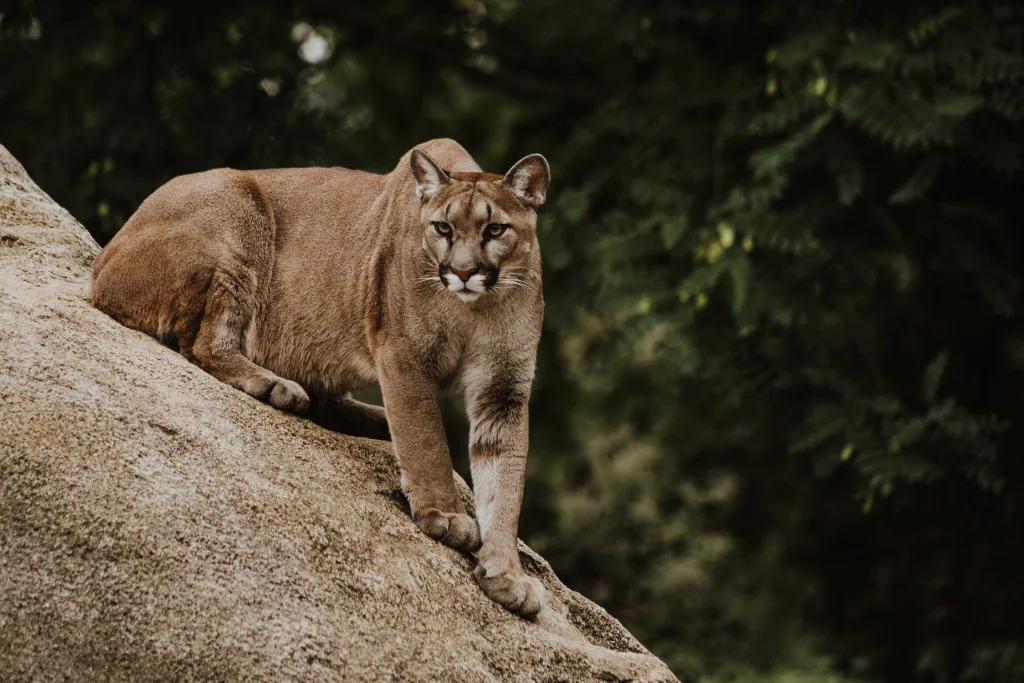The puma, also known as the cougar, mountain lion, panther, or catamount, is a majestic large cat species that can be found across the Americas. Its range spans from southeastern Alaska all the way down to the southern regions of Chile and Argentina. However, due to extensive hunting, the puma’s range has been significantly reduced, and they are now mostly found in isolated areas.
Pumas have a versatile habitat preference and can adapt to various environments. They are known to inhabit different types of landscapes, including forests, deserts, and mountains. In North America, they can be found in the cold needle leaf forests of regions such as Alaska and the Pacific Northwest. They are also known to roam the chaparral areas along the California coast and the arid Sonoran Desert.
Heading further south, pumas are found in the dense rainforests of South America, where they blend in with the lush vegetation. They have even been sighted in the towering Andes Mountains, showcasing their ability to thrive in high-altitude regions.
Currently, viable and breeding populations of cougars can be found in sixteen states in the United States. These states include Washington, Oregon, California, Nevada, Arizona, Utah, Idaho, Montana, Wyoming, Colorado, Nebraska, New Mexico, South Dakota, North Dakota, Texas, and Florida. These states provide suitable habitats for the pumas to establish and maintain their populations.
It is important to note that pumas require large territories to roam and hunt for prey. They are solitary animals, and each individual requires a vast range to sustain themselves. As human development continues to encroach upon natural habitats, it becomes increasingly important to protect and preserve the remaining areas where pumas can thrive.
Pumas have an extensive geographic range that includes both North and South America. They can be found in a variety of habitats, from cold forests to arid deserts and high mountain ranges. However, due to hunting and habitat loss, their range has been significantly reduced, and they are now mainly found in isolated areas. Efforts should be made to protect and conserve these magnificent creatures and their habitats to ensure their survival for future generations.
Where Are Pumas Most Commonly Found?
Pumas, also known as mountain lions or cougars, are primarily found in the Americas. Their range spans across both North and South America, covering diverse habitats and ecosystems. Here are some key details about the common locations where pumas are found:
1. North America:
– Western United States: Pumas can be found in states such as California, Oregon, Washington, and Nevada.
– Rocky Mountains: Pumas inhabit regions like Colorado, Wyoming, Montana, and Idaho.
– Southwest United States: Pumas are commonly found in Arizona, New Mexico, and Texas.
– Eastern United States: Pumas have been sighted in states like Florida, Louisiana, and Arkansas.
2. South America:
– Andes Mountains: Pumas are prevalent in the mountainous regions of countries such as Chile, Argentina, Peru, and Colombia.
– Patagonia: Pumas can be found in the southern regions of Argentina and Chile.
– Amazon Rainforest: Pumas have been spotted in certain areas of Brazil, Ecuador, and Bolivia.
– Central America: Pumas can be found in countries like Costa Rica, Panama, and Nicaragua.
It’s important to note that due to hunting and habitat loss, pumas’ range has been significantly reduced, and they are now often found in isolated and fragmented areas. However, they are adaptable and can thrive in a variety of habitats, including forests, grasslands, deserts, and even suburban areas.
Pumas have a wide distribution throughout the Americas, but their populations are increasingly threatened by human activities. Conservation efforts are crucial to ensure their long-term survival and the preservation of their natural habitats.

Are Mountain Lions And Pumas The Same?
Mountain lions and pumas are indeed the same species of large cat. They are also known by various other names such as cougar, panther, and catamount. These terms are often used interchangeably to refer to the same animal.
Here are some key points about mountain lions/pumas:
1. Taxonomy: Mountain lions belong to the scientific family Felidae and the genus Puma. Their scientific name is Puma concolor.
2. Physical Appearance: These cats have a similar physical appearance regardless of the name used. They are large and muscular, with a tan-colored body that is mainly covered in tawny-beige fur. Their belly and chest, however, are whitish-gray in color.
3. Geographic Distribution: Mountain lions/pumas are native to the Americas and can be found in various habitats across the continent. They are known to inhabit areas from the Canadian Yukon to the southern Andes of South America.
4. Size and Weight: Adult mountain lions/pumas are typically between 5 to 9 feet long from nose to tail, with the tail itself measuring around 2 to 3 feet in length. They can weigh anywhere between 100 to 220 pounds, with males generally being larger and heavier than females.
5. Behavior and Diet: These cats are solitary and elusive predators. They are known for their excellent jumping and climbing abilities. Mountain lions/pumas primarily feed on deer, but they are opportunistic hunters and can also prey on smaller animals like rabbits, rodents, and even livestock.
6. Conservation Status: Mountain lions/pumas are classified as a species of “Least Concern” by the International Union for Conservation of Nature (IUCN). However, their populations are declining due to habitat loss, fragmentation, and conflicts with humans.
Mountain lions, pumas, cougars, panthers, and catamounts are all different names for the same species of large cats. They are known for their tan-colored bodies with tawny-beige fur, and can be found in various habitats across the Americas.
What Climates Do Pumas Live In?
Pumas, also known as mountain lions or cougars, inhabit a vast range of climates across the Americas. Here is a breakdown of the various climates where pumas can be found:
1. Cold Needle Leaf Forests: Pumas are known to thrive in the cold, coniferous forests of North America. These forests, characterized by their needle-leafed trees, such as spruce, fir, and pine, provide suitable habitat for pumas to hunt and roam.
2. Rainforests: Pumas are also found in the lush rainforests of South America. These tropical forests, abundant in dense vegetation and diverse wildlife, offer pumas ample opportunities for hunting and shelter.
3. Chaparral: Pumas have been observed in the chaparral biome, particularly along the California coast. Chaparral is characterized by shrubby vegetation, such as chamise, manzanita, and sagebrush, and experiences a Mediterranean climate with mild, wet winters and warm, dry summers.
4. Deserts: Pumas have been recorded in desert regions, such as the Sonoran Desert. These arid environments, with sparse vegetation and extreme temperature variations, may not seem like an ideal habitat for pumas. However, they have adapted to survive in these harsh conditions by hunting smaller prey and seeking shelter in rocky outcrops or caves.
5. High Altitude: Pumas are known to inhabit high-altitude regions, such as the Andes Mountains. These mountainous areas present unique challenges, including colder temperatures, thinner air, and rugged terrain. Pumas at higher elevations may have to rely on smaller prey species, such as rodents and birds, due to the scarcity of larger prey.
Pumas have demonstrated their adaptability to various climates, ranging from cold needle leaf forests and rainforests to chaparral, deserts, and high-altitude mountainous regions. This wide geographic range highlights the resilience and versatility of these magnificent big cats.
What States Do Pumas Live In?
Pumas, also known as cougars, have viable and breeding populations in a total of sixteen states across the United States. These states include:
1. Washington
2. Oregon
3. California
4. Nevada
5. Arizona
6. Utah
7. Idaho
8. Montana
9. Wyoming
10. Colorado
11. Nebraska
12. New Mexico
13. South Dakota
14. North Dakota
15. Texas
16. Florida
These states provide suitable habitats for cougars to thrive and reproduce. The distribution of pumas in these states is a result of various factors such as prey availability, habitat suitability, and historical populations. It is important to note that the presence of cougars in these states does not necessarily mean they are found in every part of the state. They may have specific ranges within these states where they are more commonly observed.
Please note that this information is accurate as of the time of writing and may be subject to change as populations and distributions can shift over time.

Conclusion
Pumas have a vast geographic range that spans across the Americas, from southeastern Alaska to southern Chile and Argentina. However, due to hunting and habitat loss, their range has become fragmented, and they are now primarily found in isolated areas. Pumas can adapt to various environments, including cold needle leaf forests, rainforests, chaparrals, deserts, and even high altitudes like the Andes Mountains. Currently, viable breeding populations of pumas exist in sixteen states in the United States, namely Washington, Oregon, California, Nevada, Arizona, Utah, Idaho, Montana, Wyoming, Colorado, Nebraska, New Mexico, South Dakota, North Dakota, Texas, and Florida. It is essential to protect and conserve these magnificent creatures and their habitats to ensure their continued survival and biodiversity in the Americas.
